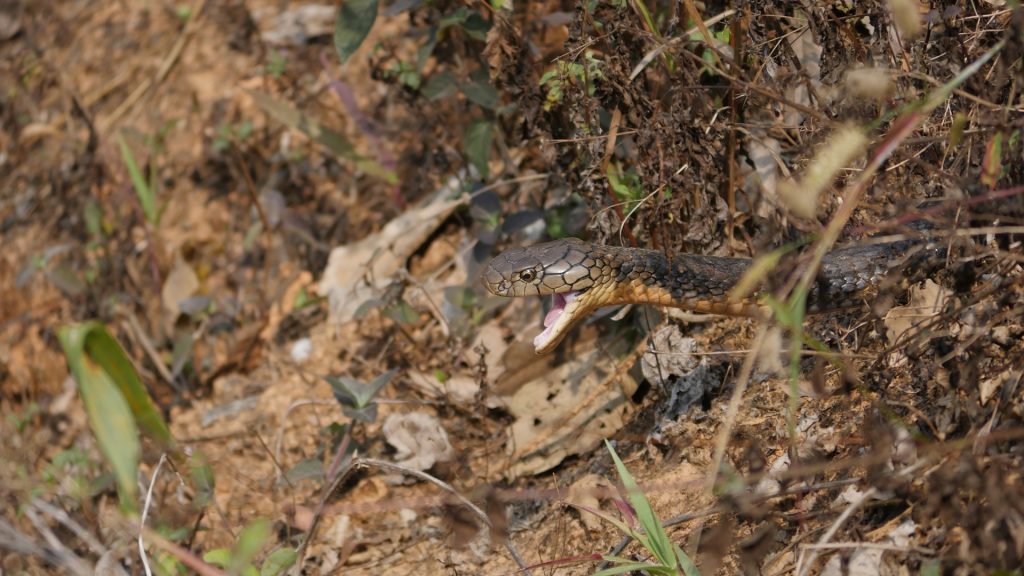
Snakes are a diverse group of reptiles that inhabit various habitats in Nepal. From the Tarai plains to the rugged mountains, snakes in Nepal have adapted to various habitats and serve as both predators and prey. These slithering creatures play a crucial role in maintaining the delicate balance of the local ecosystems and have been an integral part of Nepal’s natural heritage for centuries so they should be conserved and respected.
Culturally, snakes hold significance in Nepal’s history and traditions. They are often revered or feared as symbols of power and spirituality in various communities. The Naag Panchami festival, dedicated to the worship of snakes, is a testament to the cultural importance of these creatures. So on this occasion here are some interesting species of snakes in Nepal:
Nepal kukri snake

The Nepal kukri snake, scientifically known as Oligodon kheriensis, is a distinctive and non-venomous snake endemic to Nepal and India. Measuring between 20-30 cm in length, with some individuals reaching up to 40 or 50 cm, these snakes in Nepal feature enlarged hind teeth, which are broad and curved like the kukri (khukuri) knife.
Its colouration varies from brown or red with black markings on the upper side and a white or cream-coloured underside. This slender, cylindrical-bodied snake inhabits the foothills of the Himalayas in Nepal and India, favouring moist and shaded environments such as forests and grasslands. Its diet primarily consists of small insects, lizards, and frogs.
Despite its subtropical nature, the Nepal kukri snake is nocturnal, meaning that they hunt at night. It reproduces by laying about five eggs that hatch after around two months. These snakes in Nepal face challenges due to habitat loss, fragmentation, and the pet trade, resulting in their near-threatened status on the IUCN red list. Named after the kukri knife due to its snout’s resemblance, this snake is intricately woven into the hilly and forested landscapes of Nepal, demonstrating remarkable adaptations for its environment.
Nepal keelback

The Nepal keelback (amphiesma nepalensis) is a mildly-venomous snake species native to the forests of Nepal and other countries like India, China, Myanmar, Thailand, Laos, and Vietnam. Typically measuring 30-40 cm in length, with some individuals reaching up to 60 cm, this snake displays a brown or grey colouration adorned with black markings, while its underside is usually white or cream-coloured.
The head of these snakes in Nepal is small and round, harmonising with its slender and cylindrical body. Thriving in moist and shady environments near streams and rivers, this species is a skilled climber, often found in trees. Its diet includes frogs, lizards, and small mammals, and it lays about 10-12 eggs that hatch after approximately two months.
While not considered threatened, the Nepal keelback is susceptible to habitat loss and fragmentation. Often mistaken with the Himalayan keelback (Hebius platyceps) or the red-necked keelback (Rhabdophis subminiatus), which have similar markings and habitats.
These non-aggressive snakes in Nepal serve as valuable predators, regulating populations of various prey species. Additionally, it is popular as a pet due to its manageable care requirements. With its textured keeled scales and sleek form, this is a significant inhabitant of Nepal’s forest ecosystems, contributing to the delicate balance of its surroundings.
Himalayan pit viper

The Himalayan pit viper (gloydius himalayanus) is a venomous snake indigenous to the Himalayan region, including Nepal, Bhutan, Pakistan, India, and China. Measuring around 50-70 cm in length, with some individuals reaching up to a metre this snake showcases brown or black hues adorned with yellow markings, while its underside tends to be white or cream-coloured.
Notably, these snakes in Nepal boast a triangular head with a substantial upturned snout. The stout, cylindrical body is emblematic of this species, found predominantly in forests and grasslands at altitudes between 2,000 and 4,000 metres.
As an adept nocturnal ambush predator, the Himalayan pit viper preys on rodents, birds, and small mammals. Equipped with venom that can prove fatal, it employs an opportunistic strategy by lurking in vegetation before striking its unsuspecting prey at close range. Its venom, a potent neurotoxin, can induce symptoms like pain, swelling, numbness, and respiratory issues, potentially leading to fatality if left untreated. It is also hemotoxin and a cytotoxin, which means it can affect the blood, tissues, and cells of the victim.
While not classified as a threatened species, these snakes in Nepal remain vulnerable due to habitat degradation. Its bite, though rare, is considered dangerous, and immediate medical attention is imperative. Situated within the Himalayan ecosystem, this pit viper is a remarkable species, adeptly adapted to its challenging and unique environment.
Bronzeback snake

Bronzeback snakes, belonging to the Dendrelaphis genus, are slender and cylindrical, typically growing between 100 and 150 cm in length, though some can reach up to two metres. Their colouration varies from brown, and black, to green, often adorned with bronze or yellow markings, while the underside is usually white or cream-coloured.
Characterised by a small triangular head, these snakes in Nepal thrive in forests and grasslands across Asia, and in Australia or Papua New Guinea. Preying upon lizards, frogs, and small mammals, they exhibit diurnal activity and adept climbing skills without displaying aggression and are active at dawn and dusk.
Despite their non-threatened status, they remain susceptible to habitat loss. With approximately 60 species present in the Dendrelaphis genus, mostly found in Southeast Asia, these non-venomous snakes are occasionally mistaken for cobras due to their resemblance, though they lack the distinctive hood.
Fulfilling a vital ecological role, bronze back snakes help control populations of various creatures, rendering them a captivating subject for herpetologists and photographers. In Nepal, they thrive in forests and grasslands, displaying their arboreal nature and contributing to the intricate balance of the region’s ecosystems.
Nepalophis dhongzensis
The Nepalophis dhongzensis snake, a species in the Nepalophis genus, typically attains a length of about 60 cm. Sporting brown or grey shades complemented by black markings, with a white or cream-coloured underside, this snake features a small, round head atop a slender, cylindrical body. It inhabits the forests of eastern Nepal and India, preying on lizards, frogs, and small mammals. Active during daylight hours and not displaying aggressiveness, it lays eggs that hatch after approximately two months. While a vital part of the ecosystem, helping control populations of various creatures, the Nepalophis dhongzensis snake is classified as a rare and vulnerable species on the IUCN red list due to habitat loss, fragmentation, and pet trade activities.
Often mistaken for the common krait, it stands apart due to its smaller size and keeled underside, while exhibiting less aggressive behaviour. Contributing to scientific and photographic endeavours, this species underscores the rich biodiversity of eastern Nepal and India. Endemic to Nepal and India, the Nepalophis genus encompasses multiple small, non-venomous snake species found in diverse habitats, including forests and grasslands. The discovery of the Nepalophis dhongzensis in 2019 in the Dhonge Valley highlights Nepal’s ongoing efforts to uncover its unique wildlife and biodiversity. This recently discovered snake species in Nepal adds to the mosaic of country’s herpetological diversity, representing a remarkable contribution to the realm of scientific exploration.




















